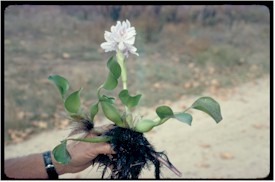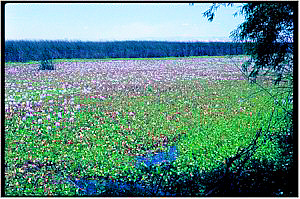|
Eco-Pros
|
|
|
|
||
|
The second worst
threat is the |
||
|
Established ecosystems have developed their own natural balance and controls over time, and the plants and animals within those systems find this balance suitable for survival, or they have been able to adapt in order to survive within those conditions. When non-native species from other ecosystems are introduced, they can upset that balance and bring harm to the established plants and animals, and the whole ecosystem. Non-native species come from somewhere else and they are not natural to the ecosystem they have been introduced to. They may be harmless and beneficial in their natural surroundings, but they can totally devastate different environments. When alien species enter into an ecosystem, they can disrupt the natural balance, reduce biodiversity, degrade habitats, alter native genetic diversity, transmit exotic diseases to native species, and further jeopardize endangered plants and animals. When there are no established natural controls, such as predators to keep the non-native harmful species in check, there can be a population explosion of the invasive non-native species causing an ecological catastrophe. Not all non-native species are invasive and harmful. But many can completely take over and entirely change whole established ecosystems. These are the non-natives that invade an established environment; therefore, they are invasive. Invasive species may be as harmless looking as green plants or a frog. They don't have to be vicious looking to bring harm to an area. They may even be beautiful to look at. This could have a detrimental effect on native species if bees or other pollinators preferred the flowering displays of the invasive species over the native species. Many humans want to design their own ecosystems to fit their needs. They bring in ornamental flowering trees, non-native fish, specialty seeds, and unusual animals. This can wreak havoc on the natural species and the established habitat. Ornamental exotic plants, flowers and trees, or animals that are brought into an ecosystem may increase the diversity of species locally; but, then the introduced species can take over, crowd out or kill the native indigenous species, and in some cases cause extinctions of particular species of plants and animals. This has happened in island ecosystems where alien species caused the total destruction of local species that existed nowhere else on the planet. Therefore, the species became extinct and the biodiversity of our planet further reduced. Tremendous damage can occur from an insect species that bores holes in trees, or weeds that take over, or zebra mussels that clog up water systems (i.e., Great Lakes). There are many species that are not native to an area which can be very dangerous and cause harm and even death to humans (i.e., brown tree snake). A non-native species could be something that brings disease to an area or to people through introduced bacteria or viruses (i.e., Ebola), or possibly a plant that would crossbreed with other plants and cause major changes to plant life. When natural habitat or food supply is destroyed, by alien species or from other circumstances, animals have to leave to find shelter and food in an ecosystem which will sustain them. Some native animals cannot leave. Without proper habitat and food supplies, they die. Many non-native species have been transported in the ballast water of ships and then are released into the waters in ports of call. Many more non-native species arrive in the products that are imported from other countries. Inspecting shipments of goods is overwhelming our human resources, such as in Florida where they have approximately 12,000 shipments of animals per year and only 8 inspectors. There has been an ever-increasing amount of international world trade in exotic species in exporting and importing of plants and animals (such as ornamental tropical fish, rainforest birds, exotic plants, and various species introduced for a purpose). This lines the pockets of the traders, shippers and sellers of these goods with huge profits of millions of dollars. But, who pays to manage and control the global transport of invasive species with regard to prevention of negative impacts? What and where are the controls, rules and environmental regulations to protect ecosystems, habitats and species from alien invasive species? Who pays for risk assessments prior to the importation of products and species? Who compensates those who have been negatively affected or lost their livelihood because a harmful species hitchhiked a ride in a plane wheel, a cargo container, in agricultural products, or in ships' ballast water? Those who originally gained the monetary benefits from the invasives pay virtually none of the costs for environmental protection, nor are they generally held accountable for the negative environmental impacts they cause. The general public, future generations, and the planet's environment and biodiversity end up paying dearly from the negative impacts of the exploitation of species, the loss of biodiversity in both the country of origin and the importing country, and for the environmental damage that occurs. Huge sums of money have to be expended to try and rectify the damage to species and ecosystems from the introduction of non-native species into the ecosystems. Once massive damage is done, there are cases where it is impossible to bring the ecosystem back to its "natural" state. Non-native species don't necessarily come from far away. They may come from neighboring areas, but from different ecosystems. If you have ever crossed a border between countries, you may have passed through an inspection point where inspectors ask if you are bringing any fruit, plants or animals into the country. The reason for this is to keep non-native species out of their particular ecosystems. "Super-highways for non-indigenous species" have occurred in such places as South Florida, where natural aquatic habitats have been drained or diverted and modified to accommodate for new development. A network of man-made canals has allowed for the expansion of non-indigenous species that could result in altering established natural systems and cause significant economic harm. The Everglades, which has suffered serious decline over the years, is already in a threatened state. This once-vibrant and massive wetland ecosystem of many habitats, is now even further threatened by many fishes that have been introduced that are out-competing native species. Other occurrences of non-native species being introduced to an area have been from aquaculture escapes, aquarium releases, state government bio-control, planting fish for sport fishing, and individuals that bring in species for various reasons, accidentally or on purpose. And there are other Alien Species
-
Humans! Along with tourists and related activities comes environmental destruction. Tourism brings in ships and jets carrying supplies and people, and the carriers and supplies themselves bring in more alien species (i.e., non-native plants, animals and organisms) which threaten and devastate native habitat and species. More people must also come to the tourist resort area to fill the jobs of the expanded tourism industry, such as in hotels, restaurants, and transportation fields. As more and more people take up residence, there is more construction and more pollution. The Galapagos is one very special place on our planet where they are striving to protect the biodiversity and ecosystems from the activities of humans. 60,000 people visit the Galapagos Islands each year. The Galapagos is considered to be a laboratory of evolution - a living library of genetic information. 95% of the known species that ever existed on the Galapagos Islands are still alive today. These creatures have had to come up with some major adaptations to solve problems in order to have survived as species for this long of a period of time. How can this biological heritage be protected from 60,000 visitors a year? 60,000 alien species who want to see this remarkable place. Strict rules have been set up as to where people and their animals can live. Off-limit areas have been set aside, such as the National Park, and guides must accompany people who wish to tour the area. They are trying very hard to keep environmental damage to a minimum, but accidents can happen that can totally destroy what species have taken many lifetimes to build. Accidents like oil spills from ships bringing fuel in to accommodate the tourism industry and the additional residents working for the tourist trade. There can be many benefits from eco-tourism, if handled in an environmentally responsible way. The millions of dollars that are generated from the tourist trade could greatly benefit the ecosystems which are impacted by the tourism industry. Funds from monies generated by tourism need to be set aside, and certain monies specified for conservation of species and restoration of habitat in those areas which incur the tourism impact. This will greatly help in our efforts to preserve biological diversity on our planet. Strict rules for environmental compliance are good and necessary. Much more needs to be done to protect our planet and its biodiversity from the invasion of alien species. Walk gently on our Earth, lest you be a harmful alien species. NON-NATIVE PETS AND PLANTS
Don't Release Non-Native Species - Escapees are Harmful
LINKS TO MORE INFORMATION ON NON-NATIVE SPECIES
InvasiveSpeciesInfo.gov
Invasive Species Bills - 109th Congress The
Center for Plant Conservation defines the terms “native” and
"exotic" as follows: What is an Invasive Species? (Audubon)
Nonindigenous Aquatic Species (U.S. Geological Survey)
Invasion!
(Ecological Society of America) Photos of Invasive/Exotic to North America Species The
World Conservation Union -
Alien Species
Invasive Species Specialist Group (World Conservation Union)
100 of the World's Worst Invasive Alien Species
- the tip of the iceberg
Introduced
Species - U.S. Environmental Protection Agency
Invasive Species - National Wildlife Federation
Introduced Species of South Florida (Florida Museum of Natural
History) Photos of Native and Exotic Species - Florida (South Florida Water Management District) "The
Great Reshuffling: How Alien Species Help Feed the Global
Economy" War
on Weeds The
Green Invader Wildland
Invasive Species Program
- From The Nature Conservancy U.S. Fish and
Wildlife Service Invasive Species Program Invasive
Species Resource Links
Center
for Aquatic and Invasive Plants and the Aquatic, Wetland and Invasive
Plant Information Retrieval System (APIRS) What You Can Do to Prevent Species Invasion (Union of Concerned Scientists) Stop
Exotics, Clean Your Boat - (Environmental News
Network) |
|||||||||||||||
|
See our
Human
Impact page
for information related to invasive species. News
Reports of Interest: "Nonnative Species Are Big Fish in U.S. Ponds"
- Diversity of native fish in U.S. in sharp decline due to introduction
of non-native species and habitat change, such as dam building and
wetlands draining. Washington Weed
Whackers |
|||||||||||||||
|
PROBLEM NEEDING A SOLUTION Due to a 7-year wet cycle in the northern prairies of North Dakota, Devil's Lake waters have risen 25 feet since 1993. 100,000 acres of agricultural land has been flooded, driving farmers and ranchers out of business. Millions of dollars have been spent to move houses and buildings, raise roadbeds, and relocate telephone and utility lines. Officials in North Dakota plan to build an artificial outlet to drain the water and lower the level of Devil's Lake. This man-made outlet will connect the lake to the Sheyenne River, whose waters join the northward-flowing Red River which feeds into Canada's Lake Winnipeg. Do you think this is a
good solution? After you give this
problem some thought, read more about it: |
|||||||||||||||
Return to
Third from the Sun
or check out our links below


